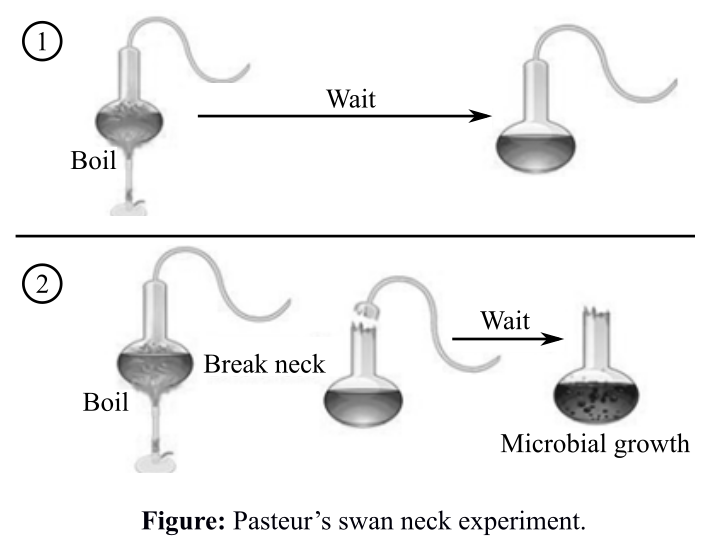
To review:
Whether the presence of thermophilic microorganisms changes the interpretation of results derived from the Pasteur’s swan-neck experiment and the experiments that could be performed to inactivate the thermophiles.
Given:
A classic experiment was performed by Pasteur to disprove the spontaneous generation of the microbes. The experiment was done in swan-necked flask as observed in the following figure:

Figure: Pasteur’s swan-neck experiment
Introduction:
Thermophilic organisms are those, which have a presence of long-chain saturated fatty acids in their membranes that allow them to withstand the high temperatures without cellular disruption. The normal methods of dry or moist heat sterilization can be evaded by these microorganisms. These organisms can resist an attack of heat but they cannot withstand detergent treatment like sodium dodecyl sulfate (SDS) and beta-mercaptoethanol.
Want to see the full answer?
Check out a sample textbook solution
Chapter 4 Solutions
Life: The Science of Biology
- How might the work of Winogradsky and Beijerinck have contributed to research on bacterial pathogens? Conversely, how might Koch and Pasteur have influenced Winogradsky’s and Beijerinck’s study of microbial ecology?arrow_forwardA microbiologist used the concept of enrichment culture to isolate aerobic and anaerobic nitrogen-fixing bacteria, sulfate-reducing bacteria, and sulfur-oxidizing bacteria. What kind of selective media could he haveused for isolating each of these four classes of microbes?arrow_forwardJohn Tyndall mostly duplicated Pasteur's spontaneous generation experiments with the swan-necked flask: occasionally however, an experiment failed due to A) Othe absence of nutrients B) O the appearance of dust. C) O the presence of fermentative microbes. D) O the lack of oxygen. E) O the presence of endospores.arrow_forward
- What are the conflicts over spontaneous generation of microorganisms? Describe the golden age of Microbiology including Robert Koch’s postulates.arrow_forwardWhat did Pasteur's results show? ► View Available Hint(s) When growth medium is not contaminated by preexisting cells, cells still grow there. When growth medium is sterilized by boiling, it remains sterile even if new cells are introduced. When growth medium is not contaminated by preexisting cells, the growth medium remains sterile. O With enough time, any sterile environment will become contaminated with cells.arrow_forwardPasteur’s experiments on spontaneous generationcontributed to the methodology of microbiology,understanding of the origin of life, and techniques for thepreservation of food. Explain briefly how Pasteur’sexperiments affected each of these topics.arrow_forward
- placing bacteria at ultracold temperatures is as effective at killing microbes as the use of dry heat in incineration. is is true/false?arrow_forwardDescribe the four major events in the early history of microbiology. Define spontaneous generation and outline the experiment by Pasteur that refuted spontaneous generation. Describe the three major events discussed in the “Golden age” of microbiology. Define chemotherapy. List the key figures and their contributions to the discovery of antibiotics.arrow_forwardWhat is the ultimate way that microbes will, as Pasteur said, have the“last word”?arrow_forward
- Give examples of organisms that would survive low temperature-long time pasteurisation. Would these organisms be killed by the high temperature-short time process?arrow_forwardHow does the streak plate technique help in isolating individual colonies of bacteria? Why streak multiple times on one plate? 3. While observing a plate inoculated with bacteria you observe a white-tan fuzzy growth. What can you interpret from this observation? Explain how this outcome could’ve occurred. 4. What are 3 possible errors that could take place as you culture your samples which could lead to contamination? State 3 and explain why. Microbiology classarrow_forwardIn 1864, Lister observed that patients recovered completely from simple fractures but that compound fractures had “disastrous consequences.” He knew that the application of phenol (carbolic acid) to fields in the town of Carlisle prevented cattle disease. Lister treated compound fractures with phenol, and his patients recovered without complications. How was Lister influenced by Pasteur’s work? Why was Koch’s work still needed?arrow_forward
 Human Anatomy & Physiology (11th Edition)BiologyISBN:9780134580999Author:Elaine N. Marieb, Katja N. HoehnPublisher:PEARSON
Human Anatomy & Physiology (11th Edition)BiologyISBN:9780134580999Author:Elaine N. Marieb, Katja N. HoehnPublisher:PEARSON Biology 2eBiologyISBN:9781947172517Author:Matthew Douglas, Jung Choi, Mary Ann ClarkPublisher:OpenStax
Biology 2eBiologyISBN:9781947172517Author:Matthew Douglas, Jung Choi, Mary Ann ClarkPublisher:OpenStax Anatomy & PhysiologyBiologyISBN:9781259398629Author:McKinley, Michael P., O'loughlin, Valerie Dean, Bidle, Theresa StouterPublisher:Mcgraw Hill Education,
Anatomy & PhysiologyBiologyISBN:9781259398629Author:McKinley, Michael P., O'loughlin, Valerie Dean, Bidle, Theresa StouterPublisher:Mcgraw Hill Education, Molecular Biology of the Cell (Sixth Edition)BiologyISBN:9780815344322Author:Bruce Alberts, Alexander D. Johnson, Julian Lewis, David Morgan, Martin Raff, Keith Roberts, Peter WalterPublisher:W. W. Norton & Company
Molecular Biology of the Cell (Sixth Edition)BiologyISBN:9780815344322Author:Bruce Alberts, Alexander D. Johnson, Julian Lewis, David Morgan, Martin Raff, Keith Roberts, Peter WalterPublisher:W. W. Norton & Company Laboratory Manual For Human Anatomy & PhysiologyBiologyISBN:9781260159363Author:Martin, Terry R., Prentice-craver, CynthiaPublisher:McGraw-Hill Publishing Co.
Laboratory Manual For Human Anatomy & PhysiologyBiologyISBN:9781260159363Author:Martin, Terry R., Prentice-craver, CynthiaPublisher:McGraw-Hill Publishing Co. Inquiry Into Life (16th Edition)BiologyISBN:9781260231700Author:Sylvia S. Mader, Michael WindelspechtPublisher:McGraw Hill Education
Inquiry Into Life (16th Edition)BiologyISBN:9781260231700Author:Sylvia S. Mader, Michael WindelspechtPublisher:McGraw Hill Education





